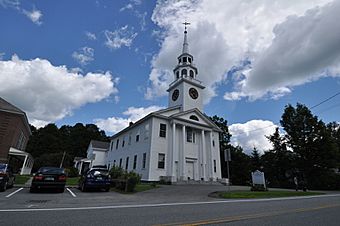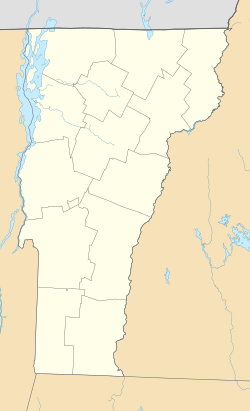Norwich Village Historic District facts for kids
Quick facts for kids |
|
|
Norwich Village Historic District
|
|

Congregational Church
|
|
| Location | Main St. from S of Elm St. to Turnpike Rd. and adjacent portions of Elm, Church, Mechanic, Hazen and Cliff Sts., Norwich, Vermont |
|---|---|
| Area | 125 acres (51 ha) |
| Architect | Emerson, Joseph; Hatch, Joseph |
| Architectural style | Colonial Revival, Greek Revival, Federal |
| NRHP reference No. | 90002116 |
| Added to NRHP | January 3, 1991 |
The Norwich Village Historic District is a special area in Norwich, Vermont. It's like a time capsule showing how the village grew. Most of the buildings were built in the early to mid-1800s. This was when Norwich University started here in 1820. (It later moved to Northfield). The district has many old buildings. They show different styles from the late 1700s to the early 1900s. This area was added to the National Register of Historic Places in 1991. This means it's a very important historical place.
Contents
A Look Back in Time
The town of Norwich was officially created in 1761. People started settling here about ten years later. The first town center was a bit north of where the village is now. The current village became more important. This was because it was closer to good farming land near the Connecticut River. Also, Norwich University started here in 1820. It was first called the American Literary, Scientific and Military Academy.
The village grew a lot around 1830. But then, some people moved west. The academy also moved away. Its first campus was destroyed by a fire in the 1860s. This caused the village population to go down.
Village Architecture Styles
A few homes from the late 1700s are still standing. But most of the buildings are from the early 1800s. These buildings show the Federal and Greek Revival styles. Later, in the early 1900s, more buildings were added. These were in the Colonial Revival style. You can also see some Late Victorian buildings. A good example of this is the Norwich Inn.
Federal Style Buildings
The Federal style was popular from about 1780 to 1840. These buildings often look simple and elegant. They usually have a balanced, boxy shape. You might see decorative details like fanlights above doors. These buildings show the early days of America.
Greek Revival Style Buildings
The Greek Revival style was popular from about 1825 to 1860. These buildings look like ancient Greek temples. They often have tall columns and grand entrances. This style was meant to show the ideals of democracy.
Colonial Revival Style Buildings
The Colonial Revival style became popular around 1880. It lasted into the mid-1900s. These buildings look back to the early American colonial homes. They often have classic features like symmetrical windows. You might see porches with columns.
Exploring the Village Center
The main road through the historic district is United States Route 5. It's also called Main Street. It runs north from Interstate 91. The district also includes some smaller cross streets. Most buildings are close to the street. They have small yards in front.
The heart of the village is the village green. This green space is where US 5 and Main Street meet. Many important buildings are around the green. These include the town hall, the library, and the post office. There are also several churches and the town's elementary school. The town's general store, called Dan and Whits, is on the west side of Main Street. It's north of the village green and next to the Norwich Inn.



